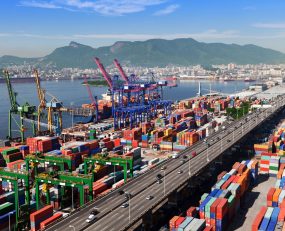
Continued supply chain congestion and the resulting inflated freight rates has led ocean shipping lines to upgrade their earnings forecasts for 2022.
A.P. Møller – Mærsk A/S (Maersk) announced on 2. August that it now expects earnings before interest, taxes, depreciation, and amortization (EBITDA) of $37bn in 2022, a 23% increase from the previous $30bn forecast. The forecast was based on “an expectation of a gradual normalisation in Ocean taking place early in Q4 2022”.
Maersk’s upward revision follows Hapag-Lloyd’s earnings guidance announced on 28. July, when the German carrier raised its earnings outlook by 30.3%. For 2022, Hapag-Lloyd’s EBITDA is expected to be in the range of $19.5 to $21.5bn (previously $14.5bn – $16.5bn) and EBIT in the range of $17.5 to $19.5bn (previously $12.5bn – $14.5bn).
A further sign of shipping lines’ good fortune are the highly profitable financial results for ONE and COSCO for the first half of 2022. The Japanese carrier ONE saw its net profit more than double for its Q1 FY2022 to $5.5bn – a record profit for ONE. ONE stated that it was “extremely difficult” to “announce a reasonable business forecast for the current financial year and as such the company’s forecasts for FY2022 are yet to be finalised”.
Similarly, Cosco’s Q2 2022 earnings reached a record high, with the shipping line expecting a 74% increase in profit in the first half of 2022 ($9.7bn), citing high export transportation fees on prime shipping lines amid tight capacity and port congestion as the factors driving profitability.
Despite demand slowing down and falling spot rates, ocean carriers have been able to sustain their profits in the first half of 2022 mainly because of ongoing supply chain disruptions. Port and landside congestion as well as container imbalances are the reason why slowing demand for goods is not translating into falling prices for ocean freight.
Supply chain disruptions continue around the world, including deterioration on the east coast of North America. In the past three months, vessel capacity between the Far East and the U.S. East Coast has risen by 18.9% year on year, according to Xeneta. The West Coast continues to lose more capacity to the East Coast because of fears of a West Coast labour strike. As the East Coast takes more share of Asia’s trade, more bottlenecks and congestion are expected on the East Coast.
According to Maersk’s Asia Pacific market update on July 29, terminal congestion, especially in North America and Europe, continues to adversely affect schedule reliability, with labour strikes in Germany making disruption worse.
The record profitability among ocean carriers and the upward revisions of their forecasts suggests that despite weakening demand, carriers will be able to charge elevated freight rates until supply chain bottlenecks are resolved. Even though more vessel capacity is expected to be added to the market in 2023, this won’t automatically translate into lower ocean freight rates because it all depends on how carriers allocate the new vessel capacity.
Having said that, ocean carriers’ good fortune will likely last until at least 2023, or until a sharp contraction in demand occurs.
Source: Transport Intelligence, August 9, 2022
Author: Viki Keckarovska